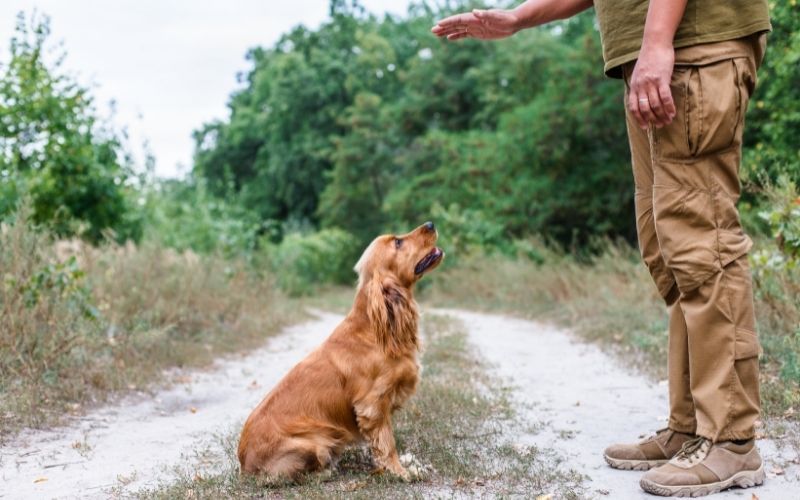There are three whistle commands that are used in spaniel training and handling. The stop whistle, the return whistle and the turn whistle for controlling your spaniel when he is hunting. The voice is also used but this is kept to a minimum and vocal commands are only given when absolutely necessary.
If you are training a working spaniel either as a pet, working dog or intend to enter competitions such as tests or trials then you’ll need to be familiar with the key whistle commands for your spaniel and adapt your training sessions to ensure that both you and your dog understand them.
Why use a whistle for spaniels?
A whistle is less disturbing to game whereas voice commands would alert pheasants and similar to your presence well before your dog had an opportunity to flush them.
They also have the advantage that they can be heard more clearly over distance or windy conditions.
Also your dog will hear human voices frequently which in most cases will sound like gobbledegook whereas the whistle is associated with specific actions – leaving no room for canine misinterpretations.
The 3 main whistle commands for a spaniel
| Command | Whistle Signal | Description |
| Sit/Hup | One long blast | Get your spaniel to sit or stop |
| Recall | Series of short blasts | Get your spaniel to come back |
| Turn | One/Two quick pips | Get your spaniel to turn when hunting |
What do we use a whistle for?
Quite simply it is to help our spaniel when he is working or, in the case of a pet, playing or running around.
The whistle is the handler’s link to his dog and, providing that the training has been embedded, it provides the handler with the means to assist his dog, from a distance, when he needs help with hunting/retrieving and other activities.

What whistle should you use?
I use the ACME 210.5 dog training whistle – I was introduced to these over 30 years ago by a professional gundog trainer and they are still widely available.
They are tough and reasonably priced ( which is important as you will lose them over time)
What are the main whistle commands for spaniels?
There are 3 whistle commands that all working spaniels, and their handlers, need to be familiar with and these are:
Returning to the whistle
This is an important command as you’ll want your dog to come back when you need him to.
It is a command that you should introduce from early days when your spaniel is still a puppy and when he is becoming familiar with his name.
The whistle command itself is simply a rapid succession of short pips on the whistle – pip, pip, pip, pip, pip, pip.
While your puppy is a youngster call his name and as he runs up to you give the whistle command to get him familiar with the instruction.
Hup or sit
I prefer Hup as it’s easier to say when you have a whistle in your mouth.
When your spaniel is hunting or running for a retrieve you’ll often need to stop him and get him to sit down.
This could be due to him having flushed game and you need him to stop so he doesn’t chase, you may need to get his attention to give him a hand signal or other instruction when helping him with a retrieve or, you may just need him to drop or sit to simply take a breather.
Either way this is one whistle command that you need to work on persistently with even the most trained and experienced spaniel – particularly if you wish to run in spaniel competitions.
The whistle command is a simple long, steady blast on the whistle of at least 2 to 3 seconds.
To help your dog to understand this command get him to sit ( using the verbal command and hand signal ) and at the same time give a long blast on the whistle so that he can begin to associate the whistle command with the act of sitting.

The turn signal
You will use this whistle command while your spaniel is hunting or quartering the ground – often this will be used in conjunction with the return whistle to help to keep your spaniel within range.
Although many well trained spaniels will hunt the ground within range without use of the turn whistle, your dog should understand and respond to the command – you may need to change direction and whistle him across or he may be pulling too far on one side or the wind direction may have altered and you need to change his pattern.
The command itself varies among handlers with some handlers giving one short sharp pip on the whistle to get their dog to turn and others giving two.
I prefer to use one as it then gives me a quick option to do another if I feel that the dog has not responded in the way I needed him to – it also makes less noise.
Whichever you prefer it’s important to practice this to keep your dog in range and hunting the cover that you need him to.
This is one activity that is good fun but it does take practice although a good spaniel will soon get the hang of it.

While you are out doing some quartering or hunting training, as you walk with your dog, give a short toot or pip on the whistle and promptly change direction, get your dog to follow you and, as he bounds past in the new direction, give another pip and change direction again.
It will soon become a big fun game and, if you encourage your dog he’ll soon get the hang of it.
Top tip for the turn signal
A great way to help your spaniel to learn this and one which will also get him hunting nicely is to try and find an area of moorland where there are clumps of rushes or clumps of tall grass.
Walk your spaniel up to a clump, tell him to ‘get on’ ( the hunting command ) and encourage him to get into the clump.
Once he’s bashed his way around that clump, pip your whistle and direct him to another one that is close to the first – try to do this into the wind so that the breeze is blowing towards your dog.
If you can find clumps that are on the left and the right then you can work your dog from one on the left to the next one on the right and so on – thus developing his hunting pattern and turn on the whistle.
Final words
There you have it. These are the 3 whistle commands that you will need for spaniel training and you won’t need anymore than this.
You may find that some handlers like to pip their whistle to get their dog to hand over a retrieve but, personally, I think that this is unnecessary and just another opportunity for the dog to make a mistake.
Keep it simple, be creative and look for opportunities to use the whistle that will help your dog to learn.
Most of all enjoy your spaniel training.




